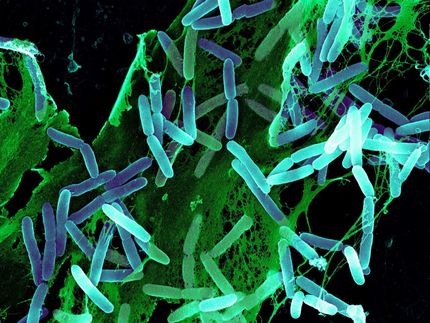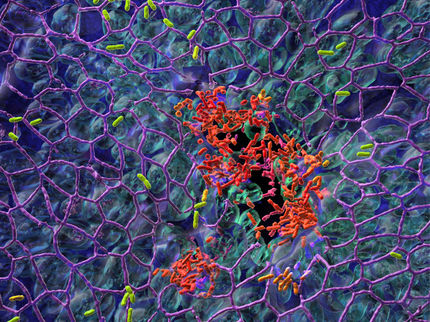New approach for antibiotic development
Researchers find mechanism against dreaded hospital germ
The opportunistic bacterial pathogen Pseudomonas aeruginosa is dangerous due to its resistance to multiple antibiotics. A research team from Heinrich Heine University Düsseldorf (HHU) and Jülich Research Center (Forschungszentrum Jülich – FZJ) has now found a mechanism that makes it possible to weaken the virulence of the pathogen. Based on this knowledge, a new approach for antibiotics can be developed, as the authors explain in the scientific journal JACS Au. The editors of the journal have dedicated a cover story to this discovery.
The bacterium Pseudomonas aeruginosa often causes a so-called “nosocomial infection” in humans. It is therefore one of the dangerous hospital bacteria that is resistant to several antibiotics. Immunocompromised patients are particularly affected. The World Health Organisation (WHO) has placed P. aeruginosa on the list of “priority pathogens” on which research efforts should focus to find new treatment options.
The bacterium has a broad spectrum of disease-causing virulence factors. These include the “type A phospholipases” (PLA1): Enzymes that can damage the membrane of the host cell and also disrupt various signalling networks in the infected cells. Preliminary work has shown that the enzyme PlaF from P. aeruginosa is a PLA1 that also alters the membrane profile and thus contributes to the virulence of the bacterium.
The research groups of Professor Dr Holger Gohlke (HHU Institute of Pharmaceutical and Medicinal Chemistry and IBG-4: Bioinformatics at FZJ) and Professor Dr Karl-Erich Jaeger (HHU Institute of Molecular Enzyme Technology at FZJ) have now identified molecular mechanisms in which medium-chain free fatty acids regulate the activity of PlaF.
The researchers carried out molecular simulations as well as laboratory studies and in vivo assays. All of these research approaches showed an indirect effect of the fatty acids on the location of PlaF in the bacterial membrane as well as a direct effect by blocking the active centre of the enzyme. In both ways, the activity of PlaF is reduced.
On the one hand, the results provide evidence that the interplay of mechanisms is a regulatory factor for PlaF function. Professor Gohlke: “We were only able to unravel these complex relationships through the interaction of computer-aided and experimental techniques within the framework of the projects funded by the CRC 1208.”
On the other hand, the results contribute to understanding the regulatory role of fatty acids. It may be possible to transfer the results to other membrane proteins that have a similar structure to PlaF.
Finally, they also open up new perspectives on how PlaF can be inhibited. Professor Jaeger: “This is a promising approach for developing new antibiotics against P. aeruginosa. These are urgently needed to combat the dangerous pathogens in hospitals.”
Original publication
Rocco Gentile, Matea Modric, Björn Thiele, Karl-Erich Jaeger, Filip Kovacic, Stephan Schott-Verdugo, Holger Gohlke; "Molecular Mechanisms Underlying Medium-Chain Free Fatty Acid-Regulated Activity of the Phospholipase PlaF from Pseudomonas aeruginosa"; JACS Au, Volume 4, 2024-2-27
Florian Bleffert, Joachim Granzin, Muttalip Caliskan, Stephan N Schott-Verdugo, Meike Siebers, Björn Thiele, Laurence Rahme, Sebastian Felgner, Peter Dörmann, Holger Gohlke, Renu Batra-Safferling, Karl-Erich Jaeger, Filip Kovacic; "Structural, mechanistic, and physiological insights into phospholipase A-mediated membrane phospholipid degradation in Pseudomonas aeruginosa"; eLife, Volume 11, 2022-5-10
Most read news
Original publication
Rocco Gentile, Matea Modric, Björn Thiele, Karl-Erich Jaeger, Filip Kovacic, Stephan Schott-Verdugo, Holger Gohlke; "Molecular Mechanisms Underlying Medium-Chain Free Fatty Acid-Regulated Activity of the Phospholipase PlaF from Pseudomonas aeruginosa"; JACS Au, Volume 4, 2024-2-27
Florian Bleffert, Joachim Granzin, Muttalip Caliskan, Stephan N Schott-Verdugo, Meike Siebers, Björn Thiele, Laurence Rahme, Sebastian Felgner, Peter Dörmann, Holger Gohlke, Renu Batra-Safferling, Karl-Erich Jaeger, Filip Kovacic; "Structural, mechanistic, and physiological insights into phospholipase A-mediated membrane phospholipid degradation in Pseudomonas aeruginosa"; eLife, Volume 11, 2022-5-10
Topics
Organizations
Other news from the department science

Get the life science industry in your inbox
By submitting this form you agree that LUMITOS AG will send you the newsletter(s) selected above by email. Your data will not be passed on to third parties. Your data will be stored and processed in accordance with our data protection regulations. LUMITOS may contact you by email for the purpose of advertising or market and opinion surveys. You can revoke your consent at any time without giving reasons to LUMITOS AG, Ernst-Augustin-Str. 2, 12489 Berlin, Germany or by e-mail at revoke@lumitos.com with effect for the future. In addition, each email contains a link to unsubscribe from the corresponding newsletter.
Most read news
More news from our other portals
Last viewed contents
Allosteric_regulation

Researchers work to create biodegradable bioplastics from food waste - Use of microorganisms to convert food waste into fats, which are then processed into bioplastics
Oral_ulcer
Glycosidic_bond
Heme
Pulmonary_hemorrhage

Researchers develop sensors for the “charge” of biological cells - Biosensors show the ratio of NADPH to NADP⁺ in living cells in real time for the first time
























































